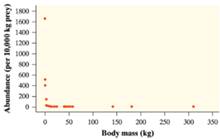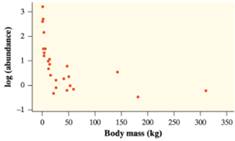
(a)
To Explain: the better relationship between abundance and body mass.
(a)
Answer to Problem 48E
Power model
Explanation of Solution
Given:



It is observed that the given
General linear model to expect log(abundance) and log(body mass).
Taking the exponential
Therefore the model associate with the model
(b)
To find: the equation of the least-squares regression line on the basis of given computer output.
(b)
Answer to Problem 48E
Explanation of Solution
Given:

Calculation:
General equation for the least square regression line
The calculated of the constant
The calculated of the slope
Putting the value of
Taking the logarithm
Where
(c)
To Explain: the prediction of the abundance of black bears on the basis of part (b).
(c)
Answer to Problem 48E
0.775532 per 10000kg prey
Explanation of Solution
Given:

Calculation:
From the part (b)
Where
Putting the value of
Taking the exponential
Therefore the expected abundance is 0.775532 per 10000kg prey
(d)
To Calculate: here is given linear regression in part (b), is it expected that prediction in part (c) to be too large, too small or about right, justify the answer.
(d)
Answer to Problem 48E
About right
Explanation of Solution
Given:

From the part (c) it is prediction for the body mass of 92.5 kilogram.
In the residual figure, it is observed that the dots between 1.5 and 2.0 are both below and above the horizontal line at 0. Moreover it is noticed that the horizontal line 0 lies in the mid between these dots and therefore it is expected that prediction at about 2 to be about right.
Chapter 12 Solutions
PRACTICE OF STATISTICS F/AP EXAM
Additional Math Textbook Solutions
Elementary Statistics (13th Edition)
Statistics for Psychology
Statistical Reasoning for Everyday Life (5th Edition)
Elementary Statistics: Picturing the World (7th Edition)
Fundamentals of Statistics (5th Edition)
Basic Business Statistics, Student Value Edition
 MATLAB: An Introduction with ApplicationsStatisticsISBN:9781119256830Author:Amos GilatPublisher:John Wiley & Sons Inc
MATLAB: An Introduction with ApplicationsStatisticsISBN:9781119256830Author:Amos GilatPublisher:John Wiley & Sons Inc Probability and Statistics for Engineering and th...StatisticsISBN:9781305251809Author:Jay L. DevorePublisher:Cengage Learning
Probability and Statistics for Engineering and th...StatisticsISBN:9781305251809Author:Jay L. DevorePublisher:Cengage Learning Statistics for The Behavioral Sciences (MindTap C...StatisticsISBN:9781305504912Author:Frederick J Gravetter, Larry B. WallnauPublisher:Cengage Learning
Statistics for The Behavioral Sciences (MindTap C...StatisticsISBN:9781305504912Author:Frederick J Gravetter, Larry B. WallnauPublisher:Cengage Learning Elementary Statistics: Picturing the World (7th E...StatisticsISBN:9780134683416Author:Ron Larson, Betsy FarberPublisher:PEARSON
Elementary Statistics: Picturing the World (7th E...StatisticsISBN:9780134683416Author:Ron Larson, Betsy FarberPublisher:PEARSON The Basic Practice of StatisticsStatisticsISBN:9781319042578Author:David S. Moore, William I. Notz, Michael A. FlignerPublisher:W. H. Freeman
The Basic Practice of StatisticsStatisticsISBN:9781319042578Author:David S. Moore, William I. Notz, Michael A. FlignerPublisher:W. H. Freeman Introduction to the Practice of StatisticsStatisticsISBN:9781319013387Author:David S. Moore, George P. McCabe, Bruce A. CraigPublisher:W. H. Freeman
Introduction to the Practice of StatisticsStatisticsISBN:9781319013387Author:David S. Moore, George P. McCabe, Bruce A. CraigPublisher:W. H. Freeman





